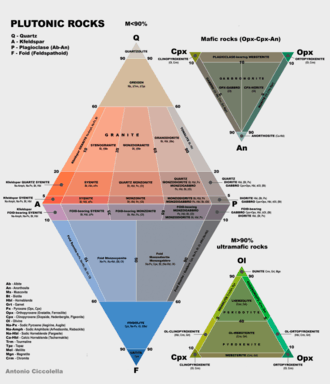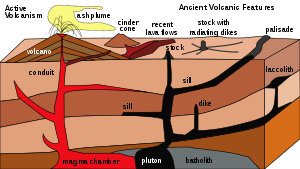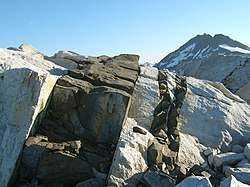Intrusive rock
Intrusive rock is formed when magma penetrates existing rock, crystallizes, and solidifies underground to form intrusions, for example plutons, batholiths, dikes, sills, laccoliths, and volcanic necks.[1][2][3] Some geologists use the term plutonic rock synonymously with intrusive rock but other geologists subdivide intrusive rock, by crystal size, into coarse-grained plutonic rock (typically formed deeper in the Earth's crust in batholiths and other plutons) and medium-grained subvolcanic or hypabyssal rock (typically formed higher in the crust in dikes and sills).


Formation
Intrusive rock forms within Earth's crust from the crystallization of magma. Many mountain ranges, such as the Sierra Nevada in California, are formed mostly from large granite (or related rock) intrusions; see Sierra Nevada batholith.
Related forms
Intrusions are one of the two ways igneous rock can form; the other is extrusive rock, that is, a volcanic eruption or similar event. Technically speaking, an intrusion is any formation of intrusive igneous rock; rock formed from magma that cools and solidifies within the crust of the planet. In contrast, an extrusion consists of extrusive rock; rock formed above the surface of the crust.
Related terms
Large bodies of magma that solidify underground before they reach the surface of the crust are called plutons. Plutonic rocks form 7% of the Earth's current land surface.[4]
Coarse-grained intrusive igneous rocks that form at depth within the earth are called abyssal while those that form near the surface are called subvolcanic or hypabyssal. Intrusive structures are often classified according to whether or not they are parallel to the bedding planes or foliation of the country rock: if the intrusion is parallel the body is concordant, otherwise it is discordant.
Intrusive suite
An intrusive suite is a group of plutons related in time and space.[5][6][7]; see Intrusive suite.
Variations
Intrusions vary widely, from mountain-range-sized batholiths to thin veinlike fracture fillings of aplite or pegmatite.
Structural types


Intrusions can be classified according to the shape and size of the intrusive body and its relation to the other formations into which it intrudes:
- Batholith: a large irregular discordant intrusion
- Chonolith: an irregularly-shaped intrusion with a demonstrable base
- Cupola: a dome-shaped projection from the top of a large subterranean intrusion
- Dike: a relatively narrow tabular discordant body, often nearly vertical
- Laccolith: concordant body with roughly flat base and convex top, usually with a feeder pipe below
- Lopolith: concordant body with roughly flat top and a shallow convex base, may have a feeder dike or pipe below
- Phacolith: a concordant lens-shaped pluton that typically occupies the crest of an anticline or trough of a syncline
- Volcanic pipe or volcanic neck: tubular roughly vertical body that may have been a feeder vent for a volcano
- Sill: a relatively thin tabular concordant body intruded along bedding planes
- Stock: a smaller irregular discordant intrusive
- Boss: a small stock
Characteristics
A body of intrusive igneous rock which crystallizes from magma cooling underneath the surface of the Earth is called a pluton. If the pluton is large, it may be called a batholith or a stock.[8]
Intrusive rocks are characterized by large crystal sizes, and as the individual crystals are visible, the rock is called phaneritic.[8] This is formed as the magma cools underground, and while cooling may be fast or slow,[9] cooling is slower than on the surface, so larger crystals grow.[8] If it runs parallel to rock layers, it is called a sill. If an intrusion makes rocks above rise to form a dome, it is called a laccolith.[8]
How deep-seated intrusions burst through the overlying strata cause intrusive rock to be characterised: Veins spread out into branches, or branchlike parts result from filled cracks, and the high temperature is evident in how they alter country rock. As heat dissipation is slow, and as the rock is under pressure, crystals form, and no vitreous rapidly chilled matter is present.[10]
The intrusions did not flow while solidifying, hence do not show lines. Contained gases could not escape through the thick strata, thus they form cavities, which can often be observed. Because their crystals are of roughly equal size, these rocks are said to be equigranular.[11]
There is typically no distinction between a first generation of large well-shaped crystals and a fine-grained ground-mass. The minerals of each have formed in a definite order, and each has had a period of crystallization that may be very distinct or may have coincided with or overlapped the period of formation of some of the other ingredients. Earlier crystals originated at a time when most of the rock was still liquid and are more or less perfect. Later crystals are less regular in shape because they were compelled to occupy the spaces left between the already-formed crystals. The former case is said to be idiomorphic (or automorphic); the latter is xenomorphic. There are also many other characteristics that serve to distinguish the members of these two groups. For example, orthoclase is typically feldspar from granite, while its modifications occur in lavas of similar composition. The same distinction holds for nepheline varieties. Leucite is common in lavas but very rare in plutonic rocks. Muscovite is confined to intrusions. These differences show the influence of the physical conditions under which consolidation takes place.[10]
Intrusive rocks formed at greater depths are called plutonic or abyssal. Some intrusive rocks solidified in fissures as dikes and intrusive sills at shallow depth and are called subvolcanic or hypabyssal. They show structures intermediate between those of extrusive and plutonic rocks. They are very commonly porphyritic, vitreous, and sometimes even vesicular. In fact, many of them are petrologically indistinguishable from lavas of similar composition.[10]
See also
References
- Intrusive Rocks: Intrusive rocks, accessdate: March 27, 2017.
- Igneous intrusive rocks: Igneous intrusive rocks, accessdate: March 27, 2017.
- Britannica.com: intrusive rock | geology | Britannica.com, accessdate: March 27, 2017.
- Wilkinson, Bruce H.; McElroy, Brandon J.; Kesler, Stephen E.; Peters, Shanan E.; Rothman, Edward D. (2008). "Global geologic maps are tectonic speedometers—Rates of rock cycling from area-age frequencies". Geological Society of America Bulletin. 121 (5–6): 760–779. doi:10.1130/B26457.1.
- Glazner, Allen F., Stock, Greg M. (2010) Geology Underfoot in Yosemite. Mountain Press, p. 45. ISBN 978-0-87842-568-6.
- Oxford Academic: Crustal Contamination of Picritic Magmas During Transport Through Dikes: the Expo Intrusive Suite, Cape Smith Fold Belt, New Quebec | Journal of Petrology | Oxford Academic, accessdate: March 27, 2017.
- 9/28/94: 9/28/94, accessdate: March 27, 2017
- Intrusive and Extrusive Rocks: Intrusive and Extrusive Rocks, accessdate: March 28, 2017.
- Sciencing: Characteristics of Intrusive Rocks | Sciencing, accessdate: March 28, 2017.
-

- rocks and minerals: Geology - rocks and minerals, accessdate: March 28, 2017.